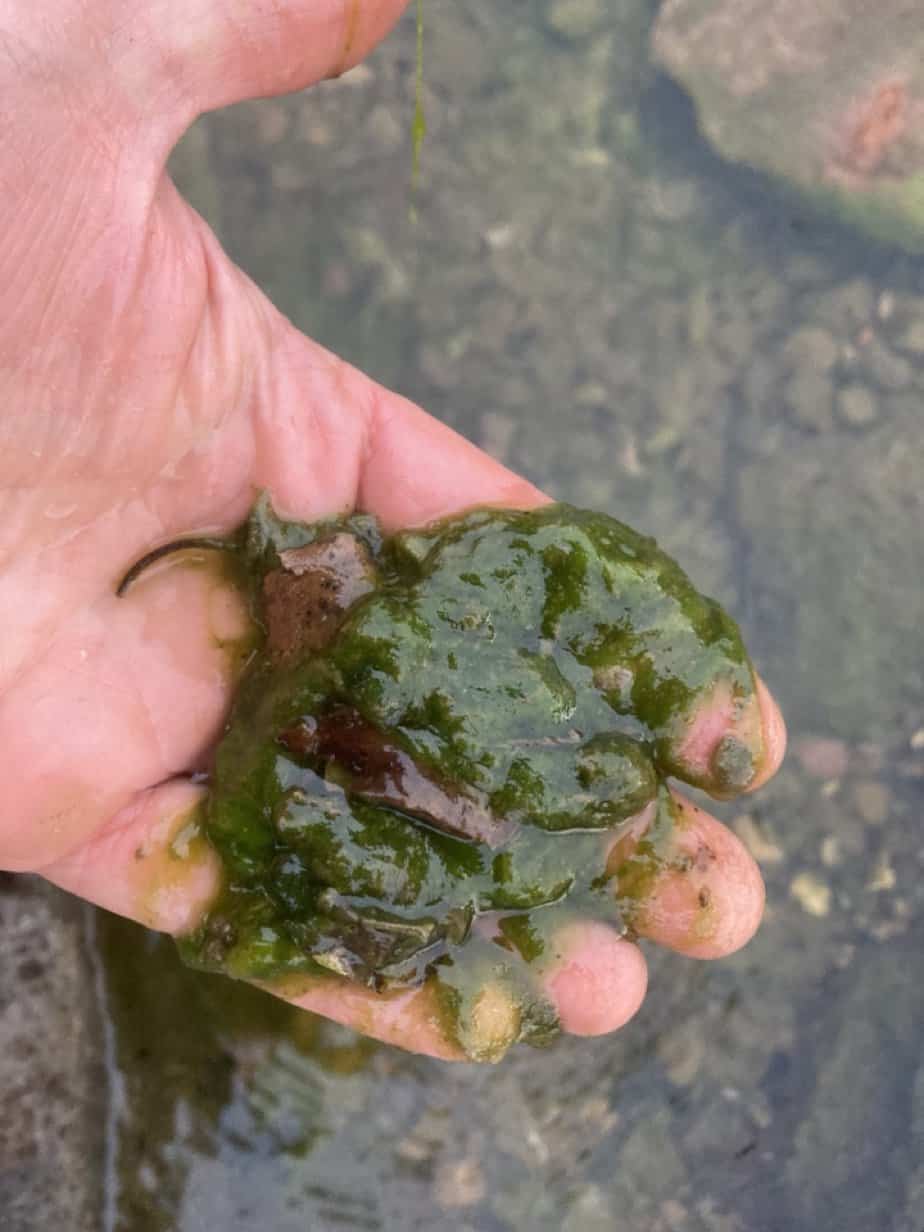A beautiful pond can be a serene addition to any garden, offering a peaceful retreat and a home for aquatic life. However, one common problem that pond owners often face is the growth of string algae or blanket weed.
String algae is a different beast than single-celled algae, this is the type that turns a pond pea-soup green. Blanket weed or string algae can be physically picked up. It often covers rocks and plants and can make the pond look very unsightly.
Understanding string algae
String algae, also known as filamentous algae, are long thread-like algae that can form dense mats inside the pond. It’s important to understand that some algae is actually good and beneficial to the overall pond ecosystem.
Algae is incredibly efficient at helping breakdown organic waste and consuming nutrients. It’s only when it gets out of control that it’s an issue. Having a small amount of algae on the rocks or sides of the pond is perfectly normal.
Generally, I’m quite happy to leave the algae if it’s an inch or two long. If it starts getting longer and I can twirl it around, that’s when I start looking for solutions.
Solutions to deal with string algae
There’s are a number of treatments and solutions we can use in our battle against string algae. Below are what I find to be most effective.
It’s also worth noting that if your pond is new, it’s quite common to experience algae as the pond ecosystem establishes itself. Sometimes all that’s required is patience.
Maintaining optimal water quality
I think the most important part of a pond is its filtration system. Understanding how nutrients are processed within a pond ecosystem are vital to success. Below is a simple explanation of how a filter process nutrients inside a pond.
The two main types of nutrients that string algae will feed on are nitrogen and phosphorous. An appropriate filter will greatly reduce the availability of these nutrients. There’s many types of filters that one can purchase or build to provide adequate filtration.
I like to build my own filters and I prefer bog filters (helpful article on bog filters), you can also purchase off the shelf filters. You can find some of the off the shelf filters, that I find are pretty good on my helpful products page.
Sometimes even with a great filter string algae can rear its ugly head, so let’s take a look at why that is.
Reducing nutrient levels
Often we buy or build a filter with a certain amount of fish in mind. Overtime the fish breed, get bigger, or probably both. As this happens the demands on the filter increase. If the filter cannot handle these demands, then the appearance of algae is sure to occur.
There’s a few things we can do to help reduce the amount of nutrient inside the pond and therefore help the filter stay on top of the algae.
- Don’t overfeed the fish. The fish in your pond will almost always be ready to take food. Don’t fall for it! Fish will pick away at algae and biofilms on all the surfaces inside the pond, they will eat micro organisms living in the pond and they will eat pretty much any protein source that falls into or lands on the pond.
- Less food means less breeding. If there’s an abundance of food the fish are less likely to self regulate their population. Adult fish looking for a meal will eat eggs and baby fry making it harder for the pond to get overcrowded.
- Adding plants. Plants will consume nutrients and their roots help increase the surface area that beneficial bacteria and organisms can grow on, which processes even more nitrogen and phosphorous.
- Removing dead or decaying plant material. Some dead leaves inside a pond is perfectly fine and even encouraged. But if these materials are allowed to accumulate unchecked and form thick layers of sludge it can be a problem. If these sludge layers are disturbed the nutrient they trapped is released into the water column.
- Using fish, shrimp and snails. Creating diversity inside the pond and a complete food chain. Animals that feed on algae will essentially used the nutrient inside the algae to fuel their own growth. Basically locking up the nutrient inside their bodies.
That’s the 4 main methods of nutrient removal that I focus on.
Physical removal
String algae is quite easy to physically remove. Because it forms in long strands, it can easily be twirled around and around and lifted out of the pond. When we remove the algae we remove the nutrient it used to grow.
In small ponds I use my hand to physically remove it. Some people like to use a toilet brush. In larger ponds I sometimes use a stick or a net like this pond shark (amazon link).
Blocking light and reducing water temperature
Some people find that the algae is most problematic in warmer conditions. Algae also needs light to grow.
Adding taller plants around the pond, shade sails or even lots of floating plants or water lily’s can help keep the water cooler.
I find in my ponds that algae is often at its worse during winter and early spring. Below is a video on my approach to algae during those times.
Products that kill algae
Sometimes it feels like you’ve tried everything and you just want the algae gone. Below are some products that can take care of it for you.
- Hydrogen peroxide or similar. Hydrogen peroxide or sodium per carbonate are great at killing algae. Here’s a link to an article and video I made on the use of both in a couple of my ponds.
- Barley straw or barley straw extract. As barley straw breaks down it releases a weak form of hydrogen peroxide. It’s very weak and quite safe and is a great option if you are worried about overdosing.
- Copper based algaecides. Copper destroys algae and is a very effective method of control the downside is it will kill beneficial invertebrates and snails.
- Nualgi and diatomix. These two products work by encouraging the growth of diatoms. Diatoms are another type of algae but less unsightly, they form the very base of the food chain and will help move nutrients up the food chain. This essentially starves the algae of the nutrient it needs to grow. There’s a link to both products on my helpful products page if you’d like to learn more.
Conclusion
Algae is a natural part of any aquatic environment and for the most part it’s something that we should be happy with. It’s only when it runs amok that we need to step in and do something about it.

